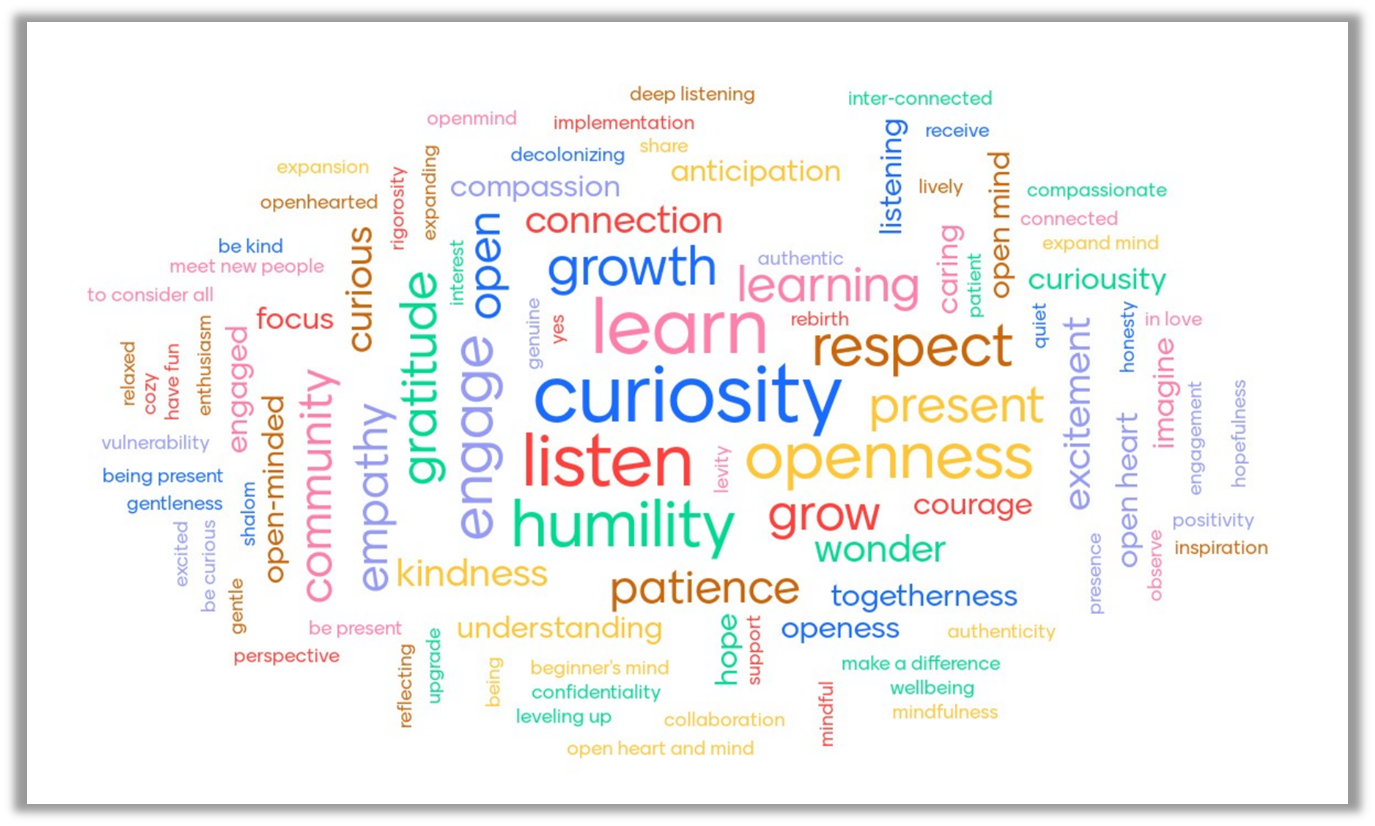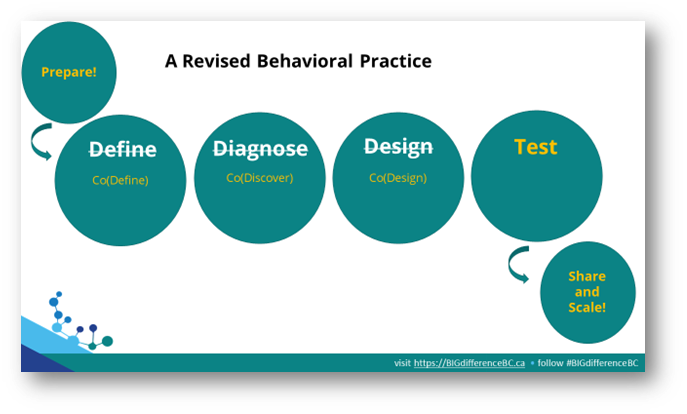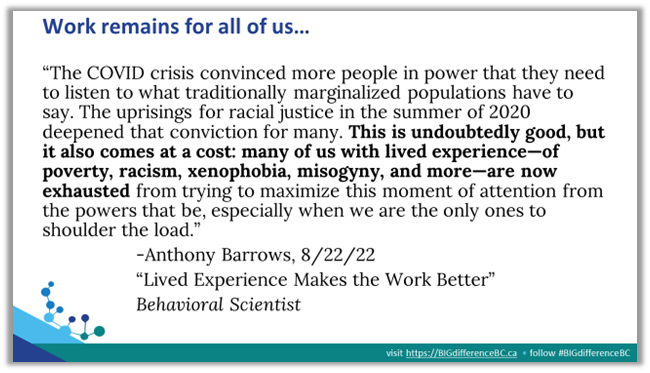Post by Stephanie Papik
Director for the BC Public Service,
Moose Hide Campaign Society
Bringing Circle Practice to BIG Difference BC
This story begins over three years ago. In early 2019, I came across the opportunity to offer a lightning talk at the 2019 BIG Difference BC conference. “Circle Practice as a Tool for Reconciliation,” was the title of my proposal. I thought this could be an opportunity to plant seeds and share ideas, knowledge and teachings within my field of science. I was keen to bring circle to the behavioral insights community as circle was identified in the 2019 BC Public Service Strategic Human Resource’s draft 10 principles workshop as a tool for cultural safety and inclusion that contributes to new ways of communicating, retention of staff, learning and education.
This year, some key components of circle were integrated into the conference—co-creating a learning and sharing space by offering agreements for our time together; making time for the relational; being intentional in how we want to show up for ourselves and each other; and shifting from a calling out culture to a calling in culture. We did this using the word cloud feature of Mentimeter. Of the 460+ participants online at the beginning of the day, 129 participated and co-created this word cloud about intentions for our shared time together.
Word cloud of audience responses to “An invitation to offer an intention or agreement for our time together” as part of our Circle Practice opening.
As a way to embody the agreements, I led participants through a grounding and self-check in exercise. Checking in and offering self-regulation through our breath offers space to shift into our pre-frontal cortex.
Toward an Anti-Racist Behavioural Science Practice
Keynote speaker, Dr. Crystal Hall, Associate Professor at the University of Washington’s Evans School of Public Policy & Governance
Circle set us up nicely for our keynote address on behavioral science and anti-racism by Dr. Crystal Hall, a decision scientist from the University of Washington. As Scott W. Allard, her Associate Dean for Research and Engagement, reflected, “Professor Crystal Hall is a singular scholarly voice challenging behavioral science to confront structural racism. Her work within the Evans School also has been integral to our school’s commitments to promote equity, address racial bias, and train the next generation of public service leaders to dismantle systems of oppression.”
I found Dr. Hall’s work to be validating, confirming and relevant to the cultural safety and humility learning and integrating that I and many other Indigenous public servants and allies have been bringing into the BC Public Service. I appreciate her approach to acknowledging what is working and building from there to make space for populations that have been excluded from the onset and into the present. Dr. Hall’s update to the practice of behavioural science highlights the importance of preparation and makes co-work central in all stages.
Slide from Dr. Crystal Hall’s keynote presentation, “Antiracist Applied Behavioral Science: Using Our Tools To Confront Structural Racism” at BIG Difference BC 2022 Conference
This is where I see we all have the opportunity to continually develop our cultural safety and humility muscles. Use it lor lose it. The First Nations Health Authority’s Policy Statement on Cultural Safety and Humility and their campaign “it starts with me” recognize that this a path each of us are on. We all have blind spots, we all have biases. So, how do we learn about these and build relationships and mechanisms to address them in strength-based ways and call each other in? If we want to engage in ant-racist ways, this is work we all have to do.
Valuing Lived Experience in Behavioural Science
Another stand-out moment was when I heard Dr. Hall share, “Folks who have the power don’t have the lived experience of those impacted.” Lived experience was a key learning as an organization at Emergency Management BC during the wildfires of 2021. Honoring the agency of Indigenous people and Nations was also a key recommendation out of Reclaiming Power and Place, the final report on the National Inquiry into Missing and Murdered Indigenous Women and Girls.
Lived experience brings together the context of impacts, the solutions and the relationships that are required to address both the symptoms and root causes. Although this can be a hard truth for some to hear, lived experience cannot be achieved by being an expert on Indigenous people obtained by a degree and/or a career of working with Indigenous People.
Slide from Dr. Crystal Hall’s keynote presentation, “Antiracist Applied Behavioral Science: Using Our Tools To Confront Structural Racism” at BIG Difference BC 2022 Conference
Barriers and Strategies for Inclusive Behavioural Science
Lastly, I appreciated Dr. Hall acknowledging the need for inclusion and some of the barriers that come up in this work. Below I’ve added in my reactions and some of how I have been addressing these barriers.
1. The problem feels too big.
The sense of overwhelm is real. All of this can feel like more work on top of the context of being in a pandemic the last couple of years. People are tired, and grief and loss are something we have all gone through. The good news is that taking on this work is a bit of a triple word score: better work, better relationships with the self, and better relationships with each other at work. Imagine meetings becoming a nourishing place, which brings me to….
2. Our research practices center whiteness.
Using circle can help decenter whiteness.
3. Our teams aren't adequately diverse with respect to race and ethnicity.
“Yet” is my favorite word. There are ways that our strategic human resources can shift practices and processes to improve. The hiring panels for hiring Indigenous Youth interns are a great example. People hire people who are like them. Since we want to hire First Nations from within and outside of BC, Metis and Inuit as well as gender diverse folks, we need to make the hiring panels reflect this and that will lead to hires that mirror this diversity.
4. We "design around" underlying issues of structural racism.
Rather than working through together.
Dr. Hall’s presentation was so much more than what I am able to reflect here; if you haven’t already, I encourage you to watch her address. We have much to learn and do in this area! I am curious if any others saw the presentations that followed with an anti-racist lens? What opportunities do others see to broaden within our behavioral science studies?





